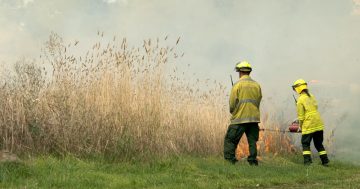
The Cotter Dam’s capacity has increased by nearly 20 times. Photo: Icon Water.
Canberra’s water provider now has the ACT’s bigger reservoirs on stream to meet the needs of the Territory and Queanbeyan as the big heat maintains its grip on the region.
Icon Water’s Owen Gould says the utility turned on the Cotter and Googong Dams this week as levels at the smaller Corin and Bendora Dams dropped, but despite a year of drought and the evaporative power of the sun this week, he says there is plenty of water to supply the region, and firefighters if a major bushfire breaks out.
“We’re not worried at all. We’d have to have another couple of years like this to start getting concerned and consider restrictions,” he said.
Mr Gould, who is in charge of strategic decision making at Icon, says the ACT’s dams could lose 10 per cent of its overall evaporation for a year in one week when temperatures sit around 40 degrees like the current heat wave. Annual evaporation ranges from 2.5 gigalitres (a gigalitre (or GL) is 1,000 megalitres, or 1,000,000,000 litres) through to over 6 GL.
Current storage is at about 65 per cent thanks to rain in December which helped steady supply, with Googong Dam at 67.21 per cent and storing 80.25 GL. Cotter Dam is at 94.83 per cent and storing 72.26 GL, Bendora Dam is at 78.19 per cent and storing 8.95 GL and Corin Dam at 26.37 per cent and storing 18.67 GL, at 15 January.
Icon says the good supply position can be attributed to infrastructure investments made in response to the Millennium Drought, such as the Enlarged Cotter Dam, combined with the water saving efforts of the community.
“The new dam alone increased the Cotter Reservoir’s capacity by nearly 20 times, and total water supply capacity for ACT and Queanbeyan grew from 207 GL to 278 GL, or about 35 per cent,” it said.
Across Canberra and Queanbeyan the community used 52.2 GL water in 2017-18.
Mr Gould says Canberrans’ behaviour change since the Millennium Drought has been amazing, with consumption consistently down 40 per cent per capita since that drought finished.
“There has been a big population increase so we do use more water but per person we don’t actually use a huge amount of water in Canberra,” he said.
Restrictions are unlikely to be considered unless dam levels drop to 35-40 per cent, with the Permanent Water Conservation Measures considered sufficient.
Mr Gould says modelling, which takes into account the drying effects of climate change and increasing population, shows it will be several decades before decisions will need to be made about augmenting supply.
High-density infill development, with smaller or no gardens, will suppress the amount of water per person used.
“We need a demand increase of about 50 per cent before we consider anything else,” Mr Gould said.
That may not necessarily be another dam, which will need a long lead time. There was a ‘whole pile of augmentation to the system we can do’, and recycling and new technology will also play a role, he said.
Icon says water in all dams is available for firefighting, such as in the recent Pierces Creek bushfire when the Cotter Dam was accessed by firefighting aircraft for water bombing purposes.
An agreement with ACT Fire and Rescue ensures firefighters have access to the urban water supply network in an emergency, with sufficient pressure and flow.
For water saving tips, click here.













